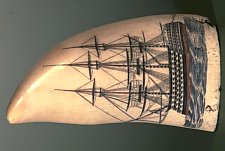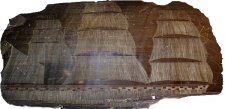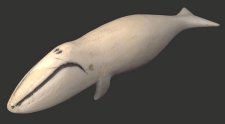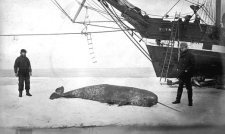| Art material |
|
Home |
Scrimshaw Arctic whaling, like warfare, involved moments of absolute excitement and terror, interspersed with long periods of utter boredom. Weeks or months might be spent in search of the elusive whales. To help pass the time whalers, particularly American whalers, created a unique folk art known as scrimshaw (from the English dialect word scrimption meaning a very small piece). This involved engraving sperm whale teeth, and sometimes baleen, with sail-makers needles. The engraved marks were often filled with chalk and oil or ink. The favourite subjects were ships and whaling scenes, and reminders of female company, family and home. Whalers also carved and decorated teeth and skeletal whalebone to make cribbage boards, chess pieces, clubs, belaying pins, canes, knife handles, dominoes, pie-crimpers, sewing swifts, and corset stays. One of the favourite pieces seems to have been the staybusk, a wide flat strip of whale-bone that was inserted into the front of a corset to prevent a woman from leaning forward and having bad posture. These presents for the whaler's wife or intended were literally worn next to the heart! Inuit carvings The Inuit of Arctic America have been in the past, and still are, skilled carvers. They used tooth and tusk ivory from walrus, seal and whales, as well as bone and soapstone and, sometimes, wood to make tools, amulets and recreational items. They have an excellent three-dimensional sense and have made carvings of the animals and objects around them over many centuries. These items were often traded for European goods during the 19th and early 20th centuries and our museums are well stocked with works of art brought back by the Greenland whalers. The tradition of carving still flourishes among the Inuit communities of Northern Canada and Alaska and their products are eagerly sought on the world art market. Many of the carvers, for example Barnabus Arnasungaaq of Baker Lake and Judas Ullulaq of Gjoa Haven, enjoy a truly international reputation. Narwhal tusks The tusk of the narwhal has been valued since mediaeval times when it was thought to be the horn of the fabled unicorn. Powdered, it was worth more than gold, as it was considered a sure-fire antidote to poisons. More recently it was an essential acquisition for natural history museums and for Victorian gentlemen putting together their own "cabinet of curiosities". As late as 1980, one was sold at a New York auction house and fetched over $12,000. Smaller specimens were carved and decorated and some used as walking sticks. The coronation throne of Denmark is constructed of many tusk and other ivory components. The Arctic whalers found a ready market for these spiral elongated, teeth as well as flensing the narwhals to top-up their barrels of bowhead blubber. Links: |





